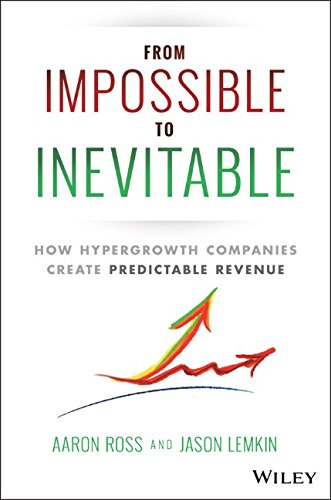From Chapter 7 of Aaron Ross and Jason Lemkin’s new book, From Impossible to Inevitable.
In 2011, Predictable Revenue came out and helped reignite outbound prospecting, and popularize both the Sales Development function and dedicated prospector teams.
Since then, the problems of outbound keep evolving:
- Human error is growing. Email and call automation has increased human error, because more activity equals more errors in response handling, following up, updating sales systems, and territory/account conflicts.
- Data is a never-ending problem: New data sources are constantly being created, but most prospectors still spend two to three hours a day building and fixing lists.
- A new knee-jerk reaction to problems is “send more email!” replacing the old reaction of “make more calls!” Doing more of what’s not working isn’t a solution.
- Overdependence on a single technique, whether it’s researching, or cold calling, or templates, or…—rather than ensuring prospectors are experts in two to four complementary techniques and understand the pros and cons of each. No one technique will work all the time, efficiently.
- Obsessing over-simplistic metrics like email open and response rates at the expense of understanding how the entire funnel works.
- Task, tool & app overwhelm. Higher-volume prospecting means more to-do lists, more follow-up tasks, and more apps, overloading prospectors.
- Phone calls aren’t obsolete: Don’t let reps succumb to “phone fear.” Pick up the damn phone! Prospectors should be having live conversations every day.
- Dashboard problems: With human error, misconceptions about how outbound should work, and common salesforce app configuration errors, it’s surprisingly hard for executives to get accurate and complete outbound funnel metrics.

Unsurprisingly, at Predictable Revenue.com we’ve built a Pipeline Automation software platform called Carburetor (orCarb.io), to solve these outbound problems. I wish I’d had it back at Salesforce.com.
For example, an early customer, Agility Recovery, saw:
- Higher quantity: Initial calls (called AWAF, or “Are We A Fit” calls), grew from 16 a month per prospector to 15 a week per prospector, approximately a 400% increase. Usually, the prospector holds the first AWAF with a prospect, confirms a possible fit, then schedules a longer Demo or Discovery call for them with a senior salesperson, who qualifies and accepts or rejects the opportunity.
- Higher quality: They raised their AWAF “call-to-close” rate from 4.6% to 12%. So out of 100 initial calls, they about tripled how many deals they closed, with better data and targeting, vastly fewer tasks and to-do’s, fewer human errors, and accurate tracking and reporting.
Stay tuned for Chapter 13 of From Impossible to Inevitable where authors Aaron Ross and Jason Lemkin discuss managing churn on a sales team and how to build a culture that inspires and retains its salespeople for the long run.
Editor’s note: Whether it’s fixing leaks in your sales and marketing funnel or just about any other sales topic under the sun, you’ll want to be in the room–virtually, of course–for the upcoming Sales Kickoff Summit 2016, a virtual event with over 30 featured speakers covering Sales, Marketing, and Social.







